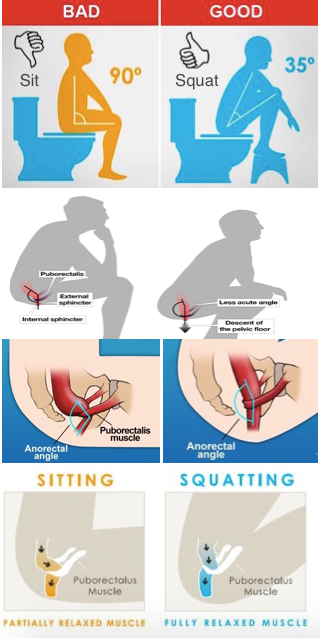2016
The fun began with NERF gun warfare with my two handsome nephews, followed by learning about the intricacies of unicorns with my beautiful niece, then concluding with the traditional Boxing Day Walk which this year was at Frensham Ponds. On route to Frensham Ponds my Mother-in-law wanted to show us her new home, a project of which both she and her husband have been working on for nearly six months. As she proudly led us around her new home (and rightly so, it’s gorgeous!) she introduced us to each room and all the features she had installed in them.
The New Design Toilet
All was looking and sounding great until she introduced the ‘Comfort Toilet’ in the ensuite, “It is much higher than the average toilet and therefore you don’t have to sit as low to go to the toilet.” My first thoughts (I didn’t share these out loud!); WTF! Second thought; current common toilet design height is not good for our bowel health nor our joints. Third and final thought; What was the thinking behind this design? Unfortunately, there is no rationale behind the design, and there is certainly no research or trials that have been conducted regarding the design – now as a scientist who designs products to market – this is complete bullshit! The providers of these ‘new’ toilets state the following: “Our range of comfort height toilets are designed to be taller than standard designs. These units are great for taller or less able users. The height on these toilets relieves the user of pressure on their knees and joints, with a much more comfortable seating position.” But is it only the ‘taller or less able users.’ users purchasing them? Or are people buying them because it ‘makes life easier’?
My first thoughts (I didn’t share these out loud!); WTF! Second thought; current common toilet design height is not good for our bowel health nor our joints. Third and final thought; What was the thinking behind this design? Unfortunately, there is no rationale behind the design, and there is certainly no research or trials that have been conducted regarding the design – now as a scientist who designs products to market – this is complete bullshit! The providers of these ‘new’ toilets state the following: “Our range of comfort height toilets are designed to be taller than standard designs. These units are great for taller or less able users. The height on these toilets relieves the user of pressure on their knees and joints, with a much more comfortable seating position.” But is it only the ‘taller or less able users.’ users purchasing them? Or are people buying them because it ‘makes life easier’?
So why could these ‘Comfort Toilets’ be detrimental to our joint and bowel health?
You’ve all probably heard of the following saying “if you don’t use it, you lose it”, well it couldn’t be any closer to the truth. There are so many mechanisms involved in squatting, some of these mechanisms are fundamental to human design, others blow off the cobwebs and allow us to keep moving safely and efficiently. Reducing squatting exposes the joints to premature aging; knees, hips, ankles, spine, and pelvis. Within the pelvis, the pelvic floor is recruited when squatting (unless there is another reason why this muscle is not working – another blog, another day!) therefore making the pelvic floor optimal. So by not squatting we reduce the opportunities for the pelvic floor to remain functional, a side-effect of this may be urinary incontinence, the second most common reason (first being Dementia) for a person to be admitted into Assisted Living (Mason et al., 2003).

So how does the common toilet height affect our bowels? And why is this new design possibly going to make things worse?
OK, so, here comes the science bit…There is a muscle in your pelvis that loops around your rectum, this muscle is called puborectalis. When the puborectalis is tight, it puts a kink in the rectum, when the muscle is relaxed, it allows the rectum tube to be fully open. This muscle, along with some other mechanisms of the digestive system, helps stop poo from falling out when we stand, walk, or run. When standing the puborectalis muscle is at it’s tightest – putting a kink in the rectum and stopping poo from falling out. When we sit, the puborectalis muscle remains tight – although less of a kink in the rectum, it remains to limit the amount of poo that comes out.Both the above may result in pushing harder to get the poo out (risk of hemorrhoids) or to take laxatives (risk of malabsorption from your food).When we squat (as per the image of the neanderthal above) the puborectalis is relaxed – the rectum is an open tube and will allow, with other digestive system mechanisms, the poo to fall out with no extra pushing nor additives.
And then came…. The Squatty Potty! For adults https://www.squattypotty.com and this video explains all (93K likes!!)
So what can we do to counteract these proposed issues?
- Ensure that only those less able bodied are purchasing these toilets.
- If you have one of these toilets purchase a small stool to put under your feet (as in the image above) to lift the knee’s higher and therefore emulating a squat position.
- Check your medication! If your medication causes bowel emptying difficulty – avoid the Comfort Toilet!
There are already comments about how the Comfort Toilet isn’t quite hitting the spot…http://ths.gardenweb.com/discussions/2308880/does-anyone-else-hate-their-comfort-height-toilet
Thanks for reading,
J




0 responses on "Is Your Toilet Making you Ill?"